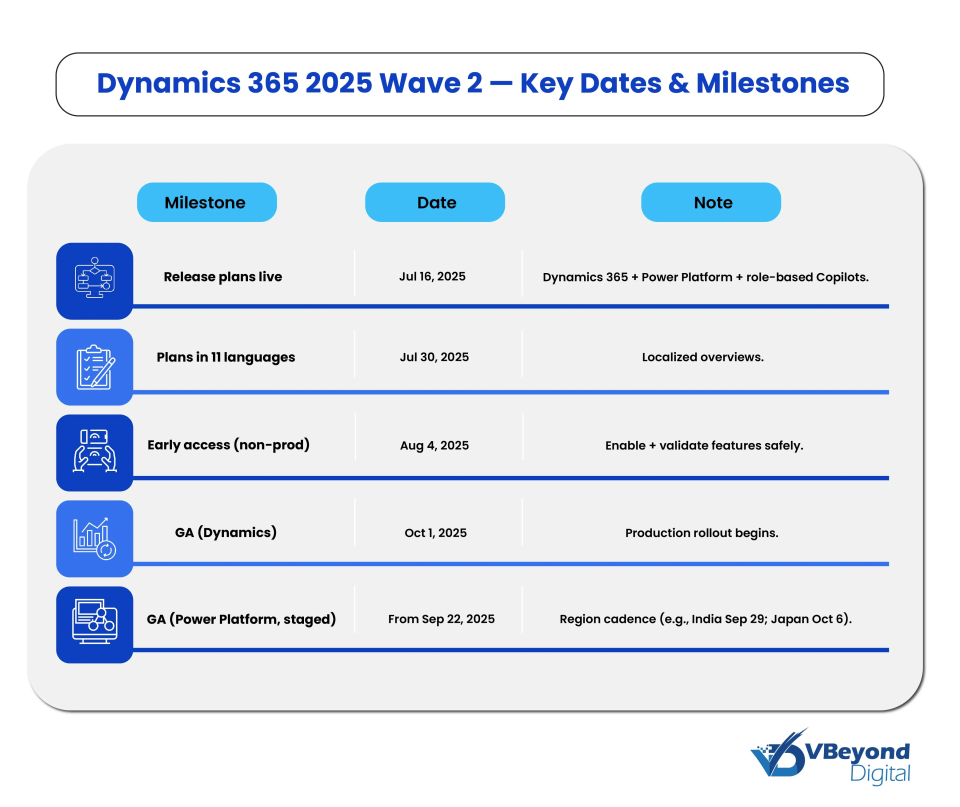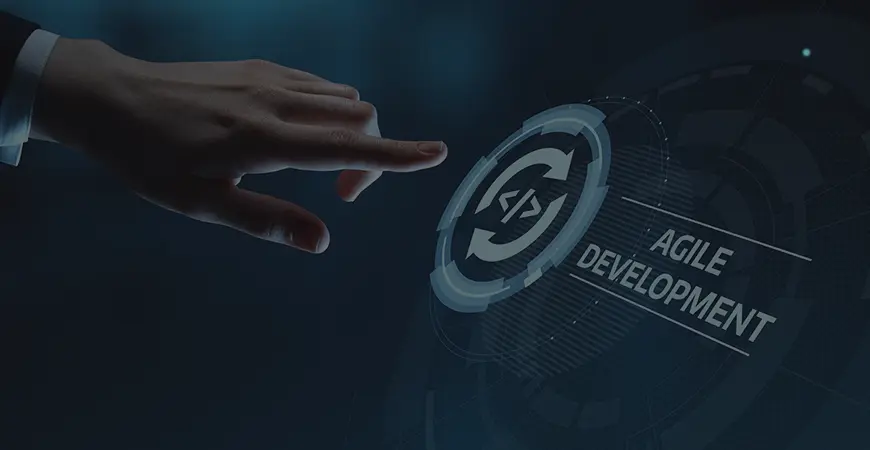Dynamics 365 Release Wave 2 Preview: What’s Coming This October
Section
- What’s coming in Dynamics 365 Release Wave 2 2025: Autonomous AI agents and Copilot expand across Sales, Customer Service, Field Service, Finance, Supply Chain, Commerce, and SMB. Expect Dynamics 365 new features that cut manual work, improve data visibility, and increase execution speed. Alignment with the Power Platform Wave 2 Release keeps agents, apps, and data in one control plane.
- Key dates and readiness: Release plans were announced on July 16, 2025 with multilingual plans on July 30, 2025; early access on August 4, 2025, in non-production; and general availability is on October 1, 2025. Act now on three tasks: sandbox validation, change management planning, and licensing review for Copilot and autonomous AI agents.
- Module highlights that matter: AI for sales automation in Dynamics 365 Sales, AI for customer service and Contact Center upgrades, Finance with a journal framework plus MCP support and natural language ERP queries, Supply Chain with event based forecasting and a Supplier Communications Agent, Business Central Copilot for quoting and order steps, Field Service scheduling gains, Customer Insights Journeys for real time orchestration, and Microsoft AI agents connected through Dataverse.
- How to capture value: Use Copilot Studio to design agent skills, apply Power Automate AI for approvals and document work, anchor governance in Dataverse, and measure results against KPIs such as sales cycle time, first contact resolution, close duration, and on time fulfillment. VBeyond Digital brings clarity and velocity from strategy to build, helping translate Dynamics 365 Wave 2 Release features into measurable outcomes.
Every October, Microsoft’s second major release wave for Dynamics 365 arrives with new features that shape how enterprises run sales, service, finance, operations, and customer engagement. The 2025 Wave 2 release is no exception. This time, it brings autonomous agents, deeper Copilot integrations, and tighter cross-platform alignment across the Power Platform.
Where previous updates reduced manual tasks, this release introduces agent-driven operations that can act continuously, coordinate across systems, and extend into customer and employee interactions. The priority now is not simply to understand “what’s new” but to evaluate what these capabilities will enable your teams to do differently: reduce sales admin time, shorten service response windows, speed up financial close cycles, and improve visibility across supply chain and operations.

Dynamics 365 Release Wave 2 Timeline & Readiness
Microsoft delivers two major release waves for Dynamics 365 each year. The second wave of 2025 is scheduled as follows:
- Release plans published on July 16, 2025, detailing planned features across Dynamics 365, Power Platform, and Copilot offerings.
- Multilingual plans are available from July 30, 2025, released in eleven additional languages.
- Early access begins August 4, 2025, providing a test window for organizations to enable and validate features in non-production environments.
- General availability starts October 1 2025, when production deployments roll out globally.
To succeed, CIOs and IT Directors should focus on three areas:
- Sandbox validation
Enable early-access features in a safe environment. Validate data flows, custom workflows, and external system integrations.
- Change management readiness
Inform leaders across departments including Sales, Service, Finance, and Supply Chain about the new capabilities and invite input on pilot rollout priorities.
- Licensing and entitlement review
Agent and Copilot capabilities may require specialized licensing. Confirm budgets and ensure licensing models are understood ahead of October 1 for general availability.
Plan Your Wave 2 Rollout Today!
AI Agents & Copilot: What’s at Work?
Power Platform & Copilot Studio: Enabling Proactive Agent Creation
Dynamics 365 Release Wave 2 2025 moves from one-shot prompts to persistent agents that coordinate across Sales, Service, Field Service, Finance, Supply Chain, Commerce, and SMB scenarios. Microsoft’s release plans confirm delivery windows from October 2025 through March 2026 and highlight tighter links with the Power Platform Wave 2 Release and role-based Copilot offerings. This section focuses on what that means for outcomes that matter to CIOs and product leaders.
Why It matters?
Autonomous AI agents and Copilot capabilities aim to reduce manual prep work and shorten decision cycles. Microsoft’s role-based plans introduce dedicated sales agents and deeper Teams, Outlook, and Microsoft 365 connections that centralize insights and actions for frontline staff.
Dynamics 365 Sales
- Problem: CRM data upkeep takes time; risk signals are easy to miss; outreach quality varies.
- What Microsoft is adding: The 2025 release wave 2 plan for Dynamics 365 Sales positions AI and Copilot as core to pipeline progress, with autonomous agents that research and engage leads, raise risk insights, and help sellers focus on closing.
This enables: Faster qualification and more consistent follow-through, with less manual data entry. Align agent behaviors to your sales process and data model, so the Dynamics 365 new features produce measurable cycle time reductions from day one.
Dynamics 365 Customer Service and Contact Center
- Problem: Slow case triage, fragmented context across channels, uneven handoffs between bots and humans.
- Microsoft is adding Copilot-driven case summaries, smarter routing, and planned Contact Center upgrades across voice and digital channels (including supervisor capabilities) are documented in the 2025 release of wave 2 plans.
- What this enables: Higher first-contact resolution and shorter handle time with AI for customer service that pairs summarization with guided actions. Tie AI steps to quality and compliance checkpoints, so gains show up in service KPIs without adding risk.
Dynamics 365 Field Service
- Problem: Scheduling friction, manual updates from the field, slow escalations.
- What Microsoft is adding: Wave 2 highlights investment in agent innovation, scheduling optimization, and technician productivity in Field Service.
- What this enables: Tighter appointment adherence and cleaner work order throughput. Map agent decisions to entitlement logic, inventory, and skills, so dispatch rules stay reliable as volume grows.
Dynamics 365 Finance and Operations Cross-Apps
- Problem: Lengthy close, cross-system reconciliation, and opaque variance drivers.
- What Microsoft is adding: The Finance plan calls out a new journal framework and accounting rules engine; the cross-app plan adds asynchronous Dual-write, natural language ERP queries, and Model Context Protocol support for agent development.
What this enables: Quicker period close and clearer variance review. Combine MCP-based agents with Dataverse governance, so actions remain auditable while reducing reconciliation backlogs.
Dynamics 365 Supply Chain Management
- Problem: Forecasting blind spots during events and promotions, manual supplier follow-ups, and quality sampling overhead.
- What Microsoft is adding: The Wave 2 plan notes additions such as event and promotion forecasting and quality improvements. Released materials also reference a supplier’s communication agent for automated vendor interactions.
What this enables: Better planning accuracy and fewer late orders, with agents nudging suppliers and surfacing exceptions for planners. Integrate these signals into your S&OP cadence to drive tangible service level gains.
Dynamics 365 Business Central
- Problem: Quote ordering requires manual checks and document handling, especially in SMB contexts.
- What Microsoft is adding: Business Central in the 2025 release wave 2 plan emphasizes tighter AI assistance within core workflows. Public communications throughout 2025 reinforce the growing Copilot footprint.
- What this enables: Guided quoting and faster confirmations. Connect Business Central Copilot to supplier availability and pricing rules, so quotes reflect current constraints without extra steps.
How Copilot Studio underpins agents
- Problem: Many processes still rely on brittle UI macros or one-off integrations.
- What Microsoft is adding: The 2025 release wave 2 plan for Copilot Studio positions it as the build surface for autonomous AI agents that coordinate tasks. Recent reporting and product updates describe “computer use” capabilities that let agents interact with apps and websites when APIs are not present.
- What this enables: Broader automation coverage, including legacy systems, with Microsoft AI agents supervising multi-step work. Add guardrails for identity, audit, and rollback, so Power Automate AI flows, Copilot Studio skills, and ERP data stay consistent.
Dynamics 365 Release Wave 2 2025 is more than application updates. The Power Platform Wave 2 Release and Copilot Studio provide the build surface, governance controls, and data plane that let autonomous AI agents move real work while staying aligned to enterprise policy. Microsoft’s release plans set the scope and time window from October 2025 through March 2026.
Copilot Studio (Agent Design, Actions, Supervision)
- Copilot Studio is presented as a SaaS agent platform for creating agents, adding knowledge and instructions, connecting tools, and operating agents at scale. The plan notes deeper integration with Microsoft 365 Copilot, autonomous agents that act for users, and capabilities such as generative answers and generative actions for dynamic tool invocation. There are controls for configuration, analytics, logging, and data retention.
Business Outcome: Faster path from idea to working agent teams inside Dynamics 365 Wave 2 Release environments. This supports initiatives that call for autonomous AI agents with clear monitoring and policy boundaries.
Power Apps (Agent-Assisted Build, Agent Feed, Data-First Experiences)
- Power Apps introduces the Plan designer where a team of agents helps build solutions that include apps, agents, and reports. The release plan describes agent apps with an agent feed that supervises agent activity and built-in agents for common tasks such as entering, exploring, visualizing, and summarizing data. These additions aim to scale intelligent AI-agent solutions with observability and recovery when agents hit roadblocks.
Business Outcome: Product teams can move from backlog items to working apps and agent pairing faster, with supervision that meets audit expectations for Dynamics 365 new features.
Power Automate (AI-first automations and human in the loop)
- Microsoft’s plan highlights AI-first automation, including generative actions, intelligent document processing, and human in the loop approvals. It also calls out enterprise-grade observability and orchestration in an automation center, a process map for end-to-end management, and ROI analytics. Tight connections exist between Microsoft 365 and Copilot Studio.
- Business Outcome: Operations leaders can run approvals and exception handling within one control plane while Power Automate AI reduces manual document work across Dynamics 365 Wave 2 Release processes.
Dataverse (governed data and model context protocol support)
- Dataverse is positioned as the foundation for building and scaling agent teams, including Dataverse for agents and improved Dataverse search to index structured and unstructured content for copilots and agents. The plan also lists a Dataverse model context protocol server to help agents retrieve and act on enterprise data, along with plugins and a knowledge center that unifies operational data, Microsoft 365 productivity data, and Microsoft Fabric analytics.
- Business Outcome: Consistent data access and supervision for Microsoft AI agents, with policies applied at the data layer rather than scattered across point integrations. Microsoft Learn
Power Pages (security agents and ALM improvements)
- Power Pages adds a security and compliance agent for admins that watches for threats such as phishing and DDoS and flags content violations. The plan also describes convergence of Power Pages authorization with Dataverse security roles, a code security scan, and CLI improvements for site lifecycle.
- Business Outcome: Faster portal delivery with stronger access controls tied to Dataverse, which matters when exposing Customer Insights Journeys preference centers or service portals connected to Dynamics 365 applications.
Dynamics 365 Customer Insights: Real-Time Engagement at Scale
Customer programs stall when data is siloed, segmentation is stale, and campaign orchestration cannot react to live signals. Dynamics 365 Release Wave 2 2025 focuses Customer Insights on three priorities that address those gaps: copilots and agents working directly against customer profiles, moment-based orchestration in Journeys, and faster time to insights through the data plane. Microsoft’s release plans confirm scope and timing for October 2025 through March 2026.
Customer Insights: Data
Purpose: Serve as the customer data platform that unifies sources into a single profile and feeds decisioning where work happens. The plan describes Customer Insights as a CDP that unifies data and produces a real-time Customer 360 view.
What is new about this wave:
Copilots and autonomous agents can use Customer Insights as a knowledge source. Teams can access unified profiles in the flow of work and act on them through agents.
Faster time insights through built-in Delta Lake support and integration with Microsoft Fabric to reduce movement and process incremental changes.
Personalization across more channels, with noted advertising integrations that help share insights across marketing endpoints
What this enables for you:
Shorter decision cycles for sales, service, and marketing teams because agents and Copilot can reference current profiles rather than static segments.
Lower data latency for analytics due to incremental processing, which supports timely actions during spikes in activity.
Customer Insights — Journeys
- Purpose. Orchestrate end-to-end engagement across channels with AI assistance for planning and execution. The product overview for this wave positions Journeys as combining customer experience, Copilot, agents, and marketing automation.
- What is new for this wave.
- Focus on Copilot and agents that help teams launch and adjust campaigns with less manual setup.
- Investment in moments that matter with enhanced orchestration and deeper integration with Dynamics 365 Contact Center for coordinated service-aware engagement.
- Ongoing feature tracking through the public “what’s new” article that summarizes early access, previews, and GA updates.
- What this enables for you.
- Campaigns that react to service events and sales signals faster, which supports revenue and retention targets without adding manual routing overhead.
How VBeyond Digital Helps Enterprises with Dynamics 365 Implementation
- We bring clarity and velocity to your digital initiatives by aligning Customer Insights data modeling with Copilot and autonomous AI agents, so actions are grounded in accurate profiles.
- We tune segmentation, consent, and governance in Dataverse and Fabric so Dynamics 365 new features in this area can be rolled into production with confidence and measurable uplift in engagement.
- We work with product and marketing teams to define high-value triggers for Journeys that tie to service events in Contact Center, sales status in Dynamics 365 Sales, and account health targets.
Conclusion
The October 2025 Dynamics 365 Wave 2 release isn’t just about new features; it’s about how quickly enterprises can operationalize them. CIOs should not wait until GA. Start now by enabling early access in a sandbox to validate data flows, workflows, and system integrations. Run cross-functional change management workshops so Sales, Service, Finance, and Supply Chain leaders can identify high-value pilot scenarios. In parallel, complete a licensing and entitlement review for Copilot and AI agents to avoid last-minute budget or access roadblocks. To capture value at scale, treat this release as an opportunity to re-architect key processes around AI agents rather than bolt on features.
FAQs (Frequently Asked Question)
It’s Microsoft’s October 2025–March 2026 update cycle for Dynamics 365. The plan published July 16, 2025, spans Sales, Customer Service, Contact Center, Finance, Supply Chain, Project Operations, HR, Commerce, Business Central, and Customer Insights, with production rollout starting October 1, 2025.
Early access opened August 4, 2025. You can turn on early access features in a non-production environment to test and validate changes before automatic enablement at general availability beginning October 1, 2025.
They’re prebuilt and configurable agents that carry out multi-step business tasks across apps. In Wave 2, Microsoft highlights stronger agentic capabilities for Customer Service and Contact Center, planning actions, routing, retrieving knowledge, and handing off to humans when needed, backed by Dataverse features that feed agents’ enterprise data.
Copilot taps Microsoft Dataverse and Power Platform services to read/write business data, trigger Power Automate flows and extend processes in apps. Finance and operations data can be accessed through virtual entities without copying, so Copilot and apps act on the same records across environments.
Highlights include agentic case management and AI routing in Customer Service; automation and supervisor tools in Contact Center; role-based Copilot improvements across workloads; and platform advances in Dataverse like prompt columns and an MCP server for agent-to-data connections. Sales also gain deeper AI assistance.



